
How to start an agency

Starting your own agency can be extremely rewarding if you get it right.
It’s true that you’ll need to spend countless hours identifying your niche, figuring out how to brand your business and unique value proposition, setting up processes, networking, and strategising growth initiatives.
But if you start an agency, you’ll be working for yourself and have complete authority on the type of clients and projects you take on, the schedule that you set and the team that you work with. And if all things go well, you’ll set yourself up to make more money than you were pulling in before.
In this article, we’ll walk you through a step-by-step guide to starting your own agency and landing your first client.
Table of contents
- What are the different types of agencies?
- Step 1: Identify your strengths
- Step 2: Determine your niche
- Step 3: Find your first client
- Step 4: Choose a suitable business model
- Step 5: Set up a work environment
- Step 6: Implement systems and processes
- Step 7: Hire the right people
- Step 8: Building a sales and marketing engine
- Wrapping-up
What are the different types of agencies?
Before we dive into how to start your own agency, let’s take a look at the different agency models that you can choose from.
There are two main types of agencies: full service and specialised. Full service agencies offer a complete range of services while specialised agencies focus on a niche service pertaining to a unique need.
For example, a full service marketing agency will be able to help clients with all things marketing, which includes strategy, content, distribution and conversion across many mediums. Whether it be content marketing, social media marketing, email marketing, inbound marketing, paid media, referral marketing, event marketing and so on, the full service agency will be able to take it on.
An example of a full service marketing agency is CW Marketing. They offer a suite of marketing services from content writing to advertising to email marketing for a variety of different types of clients.
A specialised marketing agency, however, may focus solely on content marketing. Within the content marketing niche, they may deliver services like content and SEO strategy, link building, keyword research, editorial management, blog content, ebooks, guest blogging, lead magnets and so on.
An example of a specialised marketing agency is Grizzle. They offer more specialised services to a niche target audience that focus on content marketing solutions, such as blog posts, ebooks, link building and SEO optimisation.
Full service agencies allow clients to pick and choose from a range of services, meaning you can cast a wider net in terms of your target audience. While this may make it easier to amass leads and clients, it also means that your clients will vastly vary in terms of their needs. You’ll need to be able to accommodate a variety of project scopes through multi-talented in-house staff or via outsourcing.
Contrastingly, a specialised agency focuses on more specific needs and thus your target audience will be smaller. However, because you and your team are highly skilled at what you do, you won’t need to worry about accommodating every type of client or project and can operate with a smaller, more dedicated team.
In both full service and specialised agencies, you can also choose to structure your services as a standardised or custom model. Standardised services are an out of box, one-size-fits-all type of service that allows you to crank out similar work each day for a variety of clients.
A custom model, rather, means that you will create custom deliverables based on the unique needs of your client.
Of course, you can choose to offer both standardised and custom services for different price points, as many agency owners do.
There are many types of industries that both full service and specialised agencies thrive in:
- Marketing
- Advertising
- Branding & PR
- Design and Creative
- Media
- Software development
- Customer experience (UX)
Let’s dive into how to choose which type of industry you’d like to start an agency in and how to set it up for success.
Step 1: Identify your strengths
Before you consider starting an agency, you need to fully understand your own strengths, weaknesses and interests.
This will help you decide what type of services you want to provide, who you need to hire first and who your target market is.
Knowing your strengths also helps shape your business strategy and gives direction to your agency. It’s less risky to focus on your expertise and stick to what you know instead of jumping into unknown waters.
Start by providing a single service that you have full confidence in. You can later broaden your offerings as you scale your agency. Plus, it’s important that you start an agency for the right reasons.
If you’re going after money instead of pursuing your own passion, there’ll always be a limit to how far you can take your business.
Here are some key elements involved in starting an agency that aligns with your strengths.
Do what you love
If your heart isn’t in it, running your own agency will eventually lose its lustre. It’s a long and challenging road to success, and feeling passionate about what you’re doing will help you not only survive, but thrive.
Having a strong interest in your field will keep you motivated throughout the lifetime of your agency. Even if you’re unable to land profitable clients at first, your burning passion will keep you persistent in your search.
Know your skills
Running an agency requires a diverse set of soft and hard skills, and it’s likely that you don’t have all of them.
Understanding what you’re good at and where you could use help can guide some of your most important business decisions, such as finding the right co-founder or providing top-notch services.
For example, if you’re great at the technical side of things, but not as good in leadership and people skills, you might want to partner up with someone who fills the gaps.
Plus, if there are any necessary skills you need to acquire before you start an agency, this is the time to start working on them.
Stay updated with the latest trends
As an entrepreneur, you can never stop learning.
Staying up-to-date with trends in the industry, consumer behaviour, technology and the global landscape is key to ensuring your agency’s success.
It helps you stay in touch with the landscape and demand, and align your agency’s vision and strategy accordingly.
Plus, it helps build your credibility in the market and establishes you as an expert in your field. When you have the right knowledge, you’re better equipped to understand and solve your clients’ problems.
Study your competition
Before you step into a market, you need to know exactly who you’re going to be competing with.
This requires conducting an in-depth competitor analysis of how your competitors run their businesses, what services they provide, what their past clients say about them and how much they charge.
This falls under the umbrella of market research, which helps you not only understand your competition but also your target market in general. For example, what’s the demand, market saturation and market size?
You can use all this information to guide the strategy of your agency and determine your value proposition and how you will position it in the market. For example, what factors will you consider when determining how to price your service? Does it make sense to compete by overpricing, underpricing or staying on industry average? Which option gives you the best profit margins while aligning with your strategy and goals?
Researching your competition also provides you with tons of valuable insight into what they’re doing right and what they’re missing. Use their weaknesses, or gaps in the market, to shape your agency’s strategy.
Quick Tip: We’ve created a free competitive analysis matrix to help you conduct and organise your competitor research. Click here to download the matrix, and follow the instructions provided in rows 1 and 2.
Step 2: Determine your niche
Now that you know what your agency is going to sell, it’s time to identify who you’re going to be selling to. This will help to inform your unique selling point (USP) as you begin to strategise how you will attract customers and win their business.
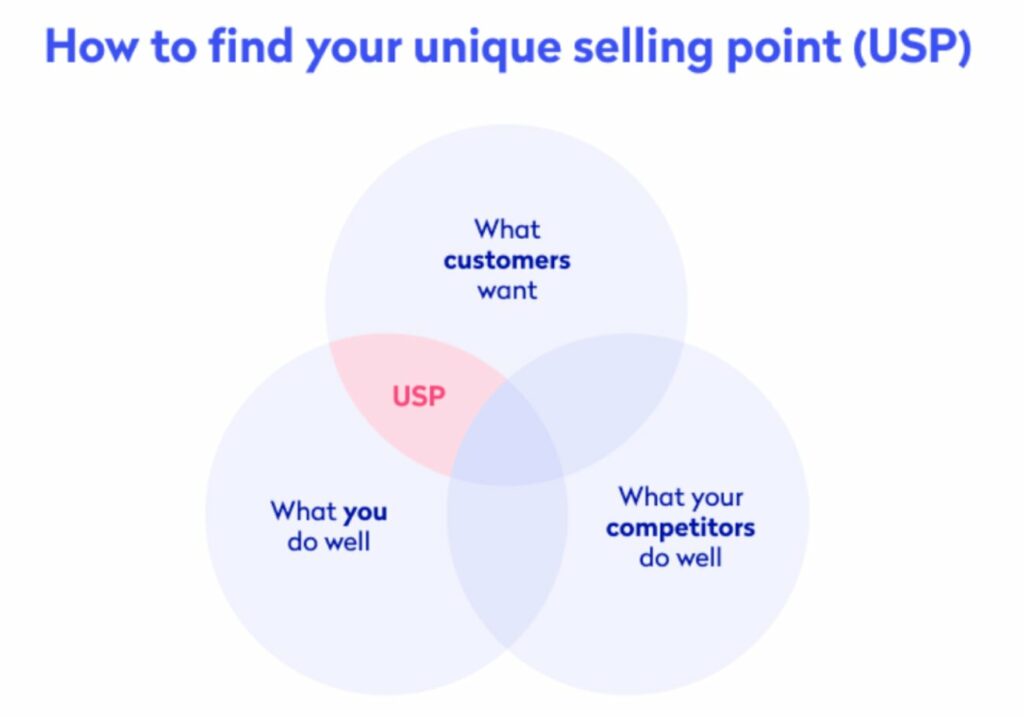
When you’re starting out, it can be tempting to go after many different types of clients. While that sounds good in theory, it can be extremely difficult to handle a diverse clientele. That’s because every business will come to you with their own set of problems and requirements.
As a new agency, you probably don’t have the workforce or capacity to cater to all of these requirements. In running all over the place trying to keep everyone happy, there’s a high chance you’ll end up pleasing no one.
That’s why it’s a good idea to identify your niche from the get-go. Focusing on a specific target market will make it easier for you to look for new clients, understand their problems and provide quality services.
Here are some benefits of identifying a niche for your agency.
Build trust and credibility
If you’re dedicated to serving a particular niche, potential clients will automatically start to trust your work. By looking at your existing clients, they’ll know exactly what you do and how you can make their business better.
Gain a competitive advantage
Identifying a niche lets you tap into markets where there is less competition or where there are significant gaps that your agency can fill. This helps establish your unique value proposition and puts you in a favourable position to gain more market share.
Learn to be the best
Catering to a specific niche means you may get clients who face similar problems to each other. This will push you to think outside the box and find different ways to solve the same problem.
This constant learning will help you become more efficient and grow to be better and provide the best valuer in your own industry.
Finding a niche will save your time, effort and money in the long run. Remember, one happy client is far better than several unhappy clients.
Use your knowledge of the industry, competition, and your own strengths and weaknesses that you gained in the first step to guide your niche identification.
Step 3: Find your first client
Finding a client before your agency is fully set up might sound counterintuitive, but it’s one of the best things you can do as a new agency owner.
Having an actual client will keep you motivated to perform your best, which can help you get more clients through referrals and positive testimonials. It will also help you better understand the needs of your target market, and learn more about the operations of your own business.
For example, you’ll get an idea of the time required to complete tasks, and even identify any particular roles that you might want to fill before you can scale your business.
Finding your first client requires persistence and looking in the right places. Here are three ways to win your first client as an agency.
Use your existing network
The best place to look for your first client as an agency is within your own circle.
If you’ve previously worked in the industry, whether as a freelancer or an employee, you likely have an existing network of people who are aware of your knowledge and credibility.
These could include past colleagues, clients you’ve worked with or any influential people you’ve met during your professional years.
Reach out to let them know about your new business and see if they know anyone who would be interested in the services you’re providing.
People who know you are more likely to trust you with their business and might be willing to give you extra time to deliver perfection. They’ll also be more open to referring you within their own circle.
Build warm relations through cold outreach
Cold-pitching is a great way to win your first client. You can reach out to prospective clients through cold calls, emails and even social media.
The key here is to know who you’re reaching out to, why they might be interested in your services and how you can help their business. Search for your type of client on Google, shortlist businesses who look like they can benefit from your services, and learn everything there is to know about them.
Only when you have a fair idea of how you can add value to their business, find a verified contact number or email, and reach out.
For example, If you’re a web design agency targeting real estate businesses, you can search for realtors in your region who could use a website revamp. Reach out to them and explain how you can help boost their conversions and user experience with a beautiful website.
Cold-calling takes time, and you might need to make dozens of calls before you get a response. It’s possible that you might even get rejected, but don’t let that discourage you.
You can use this as an opportunity to validate your offer and see whether there’s an apparent need for your services or not. For example, if most businesses reject your offer because they find it too expensive, you can consider revisiting your pricing.
Build partnerships
Partnering up with other businesses who have a similar niche to yours is a great way to find your first client.
For example, if you offer content writing services, you can partner up with web design agencies who don’t offer this service. Mutually beneficial partnerships like this can go a long way. They can benefit from broadening their offerings to attract more clients and then send them your way so you could take care of their content needs, for example.
Similarly, you’ll be happy to recommend their agency to anyone who approaches you for web design services.
Step 4: Choose a suitable business model
The next step is to decide how exactly you want to bill clients for your services, which will ultimately lay the foundation of how you’ll be managing your agency.
The billing method you use depends largely on your clients and the type of services you provide.
Here are three types of payment structures commonly used by agencies.
Flat-rate
In this type of business model, you charge a fixed rate to your clients for your services on a monthly or yearly basis.
To determine this rate, begin by assessing your clients’ needs, and then analyse the hours you’ll be putting in to deliver those services.
If your clients frequently change their requirements, a flat-rate model isn’t advisable for you. You might end up doing more work and not getting paid for your extra time.
Commission
In this pricing structure, agencies get paid when their clients make money from a sale. For each sale that a client makes, a certain percentage goes to the agency.
This isn’t applicable for all business types, since most services aren’t directly tied to sales. A commission-based model is more suitable for agencies who help their clients sell things, such as ecommerce solutions.
Hourly
You can also choose to charge your clients on an hourly basis.
However, this business model isn’t entirely suitable for businesses who work on large-scale projects that can last for weeks or even months.
The hourly-rate model is ideal for consultancy firms and other agencies who provide short-term services, such as creating a strategy for clients or helping them make business decisions.
Productised service vs. traditional consulting
A productised service is your value proposition and scope of work packaged at a certain price.
For example, a creative agency can offer several packages aimed at solving a specific problem with specific deliverables, like a brand identity package that develops your brand voice and visual identity at a set price.
Agencies can also choose to offer several tiered plans, such as Silver, Gold and Platinum, so clients can choose the one that best fits their needs.
A traditional consulting model treats each and every client as unique. This means you’ll need to develop a tailored proposal for each client.
This is ideal if your clients typically have different needs and requirements. But if you’re catering to a specific type of client with very specific needs, productising your services is a great idea.
Not only does productising your services make it easier for prospective clients to do business with your agency, but it enables your agency to successfully meet client expectations and follow systematic processes to complete projects.
Productising your services also makes scaling your agency a lot easier, as you already have systems and processes in place.
Quick Tip: Creating a business plan will help you answer all of these key foundational questions and help you set a realistic business budget to ensure you keep a steady cash flow as you build revenue and grow. To learn more about how to get your agency off on the right foot, read our article on How to create a business plan in 2020: A complete guide to writing your company roadmap.
Step 5: Set up a work environment
Before you can hire people in your agency, you must decide on the type of work environment you want to foster.
Not only will this affect your agency costs and hiring strategy, but it will also guide the culture of your business and its people in the long run.
Generally, you have three options for your work environment: a physical office space, a fully remote workspace, or a hybrid of the two via a coworking space or a serviced office space.
Remote
If the operations of your agency don’t require physical presence, it’s a good idea to consider a remote work environment. It’s easier on your budget and can positively affect the productivity of your employees. And given the current COVID-19 pandemic, starting an agency with a remote team is a safe choice as the world grapples with this global crisis.
Here are some advantages to choosing a remote work environment:
- Zero or lower overhead expenses
- Better work-life balance for employees
- Increased productivity
- Access to global talent
- Improved employee retention
- Reduced salaries
Remote work environments are ideal for digital marketing, web design and other agencies that provide services through the internet.
Physical office
If physical presence is important for your agency, such as for security reasons or nature of work, it’s a good idea to get an office and hire in-house employees.
For example, if you’re running a financial services agency, you’d want to consider having a physical work environment as your employees would be dealing with sensitive client information.
Physical offices are also ideal for creative agencies, consultancy firms and other businesses that require a lot of face-to-face interaction and relationship-building with clients.
Here are some advantages to choosing a physical work environment:
- More networking opportunities
- Relationship-building with coworkers
- Helps establish your presence in front of clients
- Easy to conduct brainstorming sessions and creative meetings
- Easier to collaborate on creative projects
Changing your agency’s work environment down the line can disrupt your employees’ morale, which is why you should make a decision before you start hiring.
See what works best for your own agency and invest in making it happen.
Step 6: Implement systems and processes
Implementing effective systems and processes in your agency keeps things organised, makes it easier to manage day-to-day activities and helps you scale your agency with less friction.
They also provide direction to your managers and employees—what roles they have, who they’re reporting to, what is expected of them and how they can grow in your agency.
Here are some useful tools to help you implement and streamline various systems and processes in your agency.
Slack: Business communication

Slack is a workplace communication tool that allows you to send instant messages and share files with your colleagues.
You can create channels and groups, or communicate directly with your coworkers or employees. Slack is especially useful for remote teams looking to collaborate more effectively, as it is designed with asynchronous communication in mind.
Asana: Project management

Asana is a popular tool that helps businesses track, assign and manage projects.
You can create sprint plans and assign them to your employees, track their performance and ensure you deliver projects to your clients on time.
You can even collaborate with your colleagues by sharing instant feedback, files and status updates.
Pipedrive: Sales management
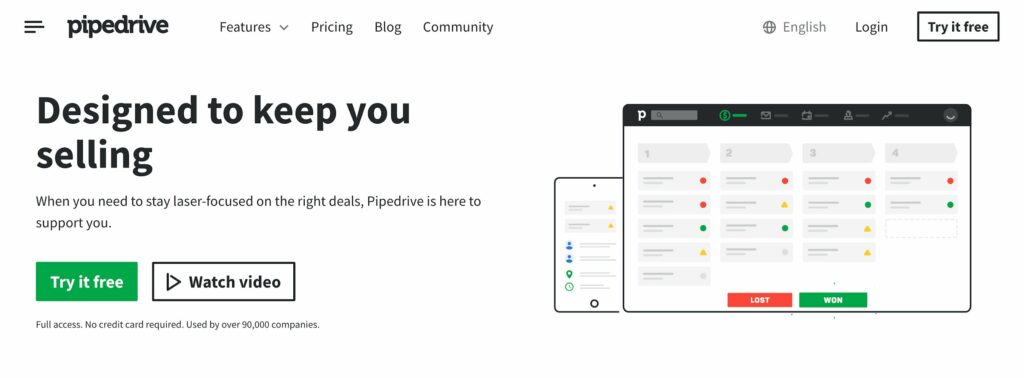
Pipedrive helps you streamline your sales processes and keep all your client communication in one place.
This tool is designed to help your business manage leads and deals, track messages and emails, automate tasks, keep a sales activity calendar, and access detailed insights and reports.
QuickBooks: Accounting and bookkeeping

QuickBooks is a cloud accounting software that can help your agency track all of its sales, expenses and profits.
It also lets you create and send custom invoices to your clients, as well as manage your sales tax. The best part is it comes with a mobile app so you can manage your accounting on the go.
Quick Tip: We have a seamless integration with Quickbooks (as well as several other accounting integrations) that allows you to sync your Tide business current account with your accounting software of choice. These integrations allow you to automatically categorise transactions and expenses which simplifies your bookkeeping efforts and frees up valuable time.
Tide: Banking and payments

Tide is a mobile banking app that lets you create and manage a business bank account on the go. Through our platform, you can easily view and auto-categorise transactions, create and pay invoices, switch between accounts and manage multiple cards.
We also make it easy for you to register your limited company for free, an important step in making your agency more official and credible.
Step 7: Hire the right people
When you’re starting out, you’ll probably be on your own or with a co-founder at most. It’s ideal to do it yourself” for as long as you have the capacity to do so. This helps you save tons of money and generate capital as a safety blanket.
It also helps you learn the ins and outs of your agency, so when the time comes to hire, you’ll know exactly the type of person you need and what they’ll be required to do.
But when you start to scale your agency, you’ll find yourself constantly busy with day-to-day tasks. This will eventually leave you with less time to strategise and build relationships, which is what a founder should be focusing their energy on.
This is when you should start hiring the right people for your agency.
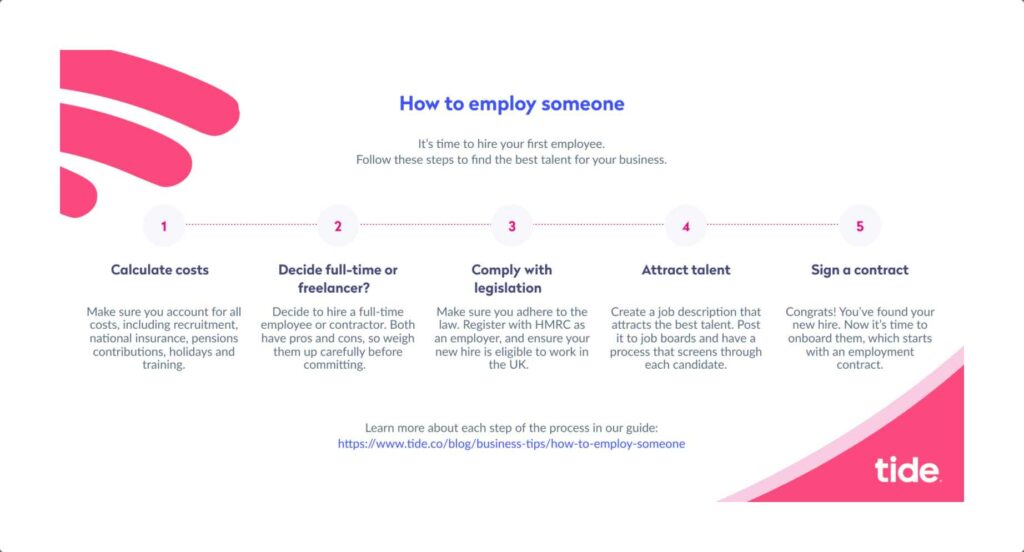
Start by filling the most important roles first. For example, you might need to hire a finance person to handle accounts, taxes and client payments right at the beginning.
If you’re a creative agency, you’d likely need to hire more people, including a photographer, a designer and a developer, depending on your needs.
It’s a good idea to keep a small team for as long as possible. The more people you hire, the harder it becomes to manage them. Hiring a small team also makes it easier for you to guide them and solve any issues your team members face personally.
You should also consider whether you want to hire full-time employees or freelancers for your agency. Some roles, like those in a creative agency, can easily be filled by freelancers. This is because the nature of work is mostly project-based.
Other roles, such as accountants, might need to be filled by full-time employees as these people will be handling more than one project at a time. You can also choose to have a mix of both kinds of employees. Make sure you identify your needs beforehand, as this will largely affect your costs.
Quick Tip: Hiring your first contractor or employee is exciting, but you need to make sure you’re following legal requirements and best-practices before signing a contract. To learn more about the steps you should follow when considering bringing on new talent, read our guide on how to employ someone (for the first time).
Step 8: Building a sales and marketing engine
You might be wondering why we’ve kept this step for last.
The reason is that while it’s tempting to go all-in on the marketing for your agency right in the beginning, you’ll see better results if you already have proper systems in place.
Here are several ways to build a powerful sales and marketing engine for your agency.
Develop a marketable brand
Before you can start selling your services, you need to develop a strong brand that resonates with your target customers.
The first step is to define your agency’s mission, vision and values. Knowing why you exist, what you hope to achieve and how you plan to get there is key to your agency’s success.
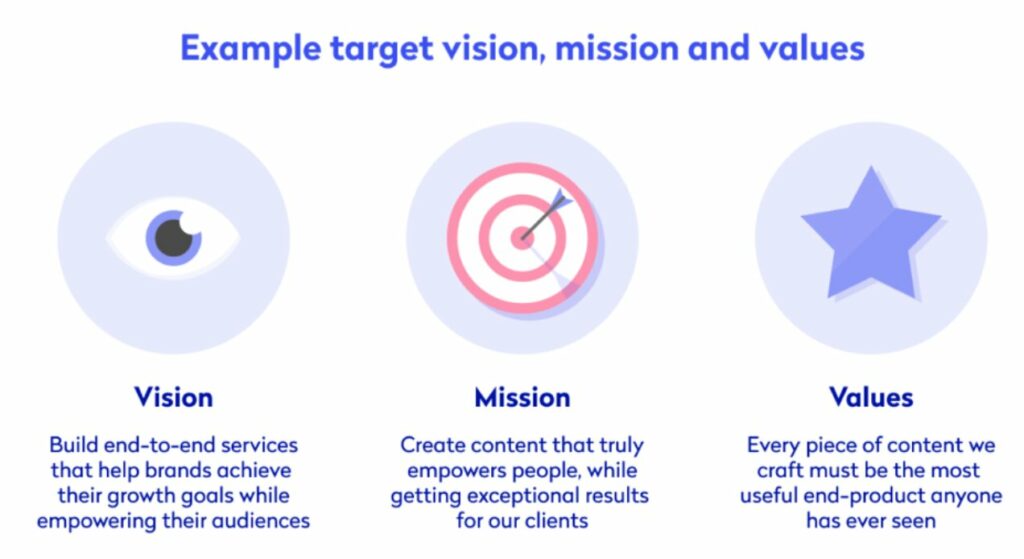
It will also help guide the creation of your visual brand identity and brand voice. A visual brand identity includes your logo, colours, fonts, imagery and any other visual element that will represent your brand in front of your customers.
It’s important to have a strong and meaningful visual identity, as it helps build an emotional connection with your prospective clients and shapes how they perceive your agency.
Once you have the foundations of your brand ready, it’s time to communicate with your target customers and show them why they should come to you.
Quick Tip: Building a strong brand is no easy task. It requires time, dedicated research, and introspection. As consistent brand positioning across channels boosts revenue by 23%, it’s worth the effort. To learn more about how to strategically build a strong brand, read our guide on how to build a brand that customers love in 7 steps.
Establish an online presence
A powerful online presence is necessary for your agency in 2020.
Regardless of which industry you’re in, your customers are likely searching for your services online. If you don’t show up at the right time, you’re going to lose potential business to your competitors.
The first thing you should do is create a beautiful website that clearly communicates what your agency does and how potential clients can get in touch.
You should also set up your social media profiles on platforms that are most relevant to your business. For example, if you’re a digital travel agency, you should definitely have a page on LinkedIn, Facebook and Instagram so that clients can find you in their online searches and read reviews and community feedback.
Invest in content marketing
An online marketing presence that doesn’t show up when needed is not of much use to anyone. When prospective clients search online to find a service or solve a problem, you should show up with all the right answers that directly correlate to the stage of the marketing funnel they’re in.
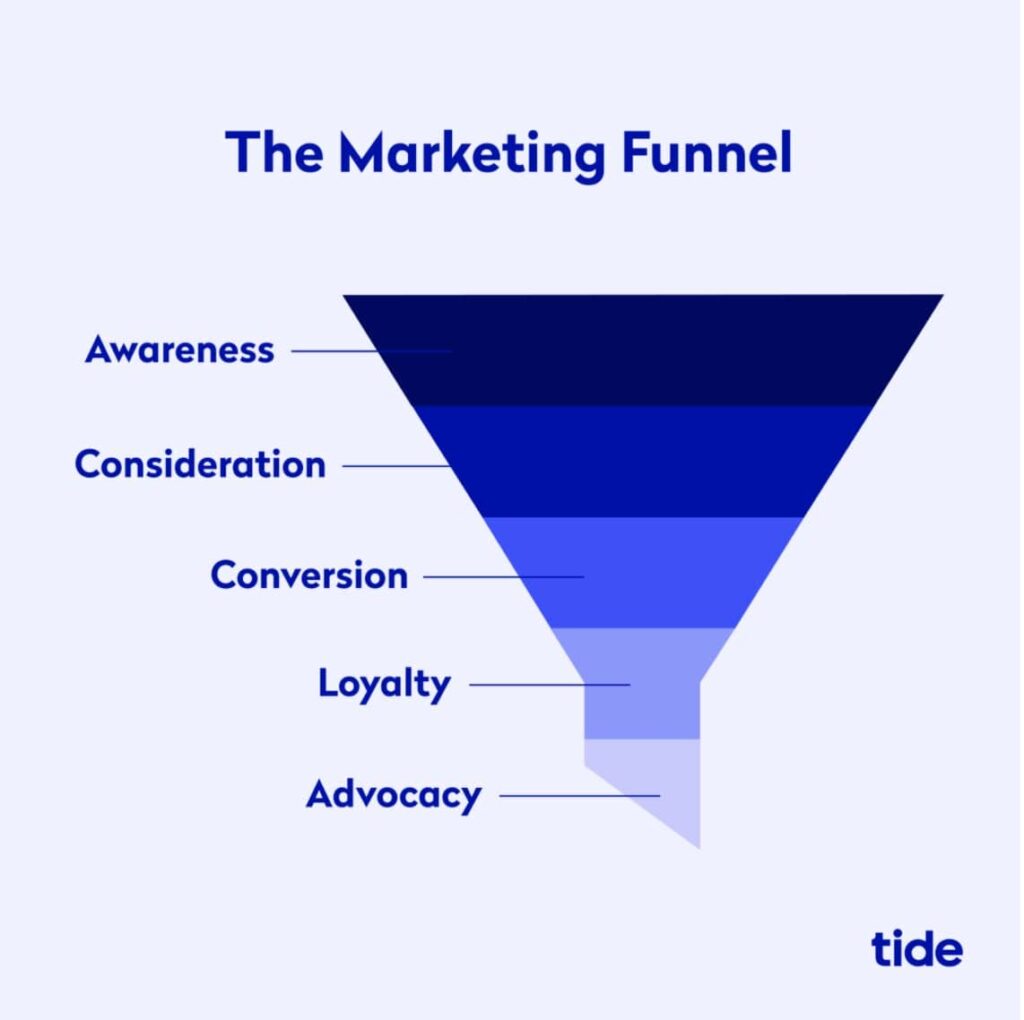
The best way to do that is through high-quality content optimised for search engines, or SEO. Similar to developing a strong brand, you must devote time to building an effective go-to-market (GTM) strategy. This will help you to standardise your messaging, define your client journey and ultimately help you generate interest and close sales.
Depending on your industry, you can publish content online in the form of:
- Blog posts
- Video
- Social media posts
- Case studies
- Whitepapers and eBooks
The more content you publish around relevant keywords with a high search volume, the more likely you’ll be to show up in front of the right type of clients.
You also need to ensure you’re promoting your content on the right channels, such as social sharing and paid advertisements. This helps you get more eyeballs on your content, drives more traffic to your website and helps you land more clients.
Quick Tip: Besides a go-to-market strategy, you also need a complete digital marketing strategy that will help you align your activities with the stages in your marketing funnel and inform you on where, when and how to publish online. To learn more, read our guide on how to create a complete digital marketing strategy for small businesses.
Streamline your sales process
While marketing helps to identify and acquire prospective clients, sales is responsible for building a relationship with potential clients—, showing them how your agency can help them reach their goals and successfully converting them into paying customers.
Make sure you have a structured sales process in place, from qualifying leads to closing deals and following up after. It should also be aligned with your marketing strategy so you end up with clients who are actually interested in your services.
A good sales process focuses on building lasting client relationships. It involves doing background research before making a pitch, carefully listening to your client problems, presenting them with multiple solutions and delivering on your promises.
It also involves ensuring a healthy relationship after a deal has been closed. If your existing clients are happy with your services, it can mean referrals and repeat business for you.
Wrapping up
With tons of tools and resources at your disposal, starting an agency is easier than ever.
However, to set your agency up for success, you need to make sure you’re starting it for the right reasons. You also need to make some important decisions before you devote too much time and effort into building out your UVP and USP.
Strategic and careful decisions at the outset will guide your agency in the right direction and give you the best chance of success.
Ready to start your own agency?
Setting up your business with Tide is incredibly fast, easy and free. You not only get to officially start your company, but you get a free business current account at the same time, which is the best way to ensure you’re keeping your finances in order from day one. Be your own boss and register your company with Tide! 🎉
Photo by S O C I A L . C U T, published on Unsplash




